|
HOW TO CARE FOR YOUR FISH
|
|
Follow these fish handling tips to preserve the quality of your catch. If you handle your fish with care, it will be well preserved for processing and eating.
|
|
LANDING
|
|
Tip 1.
Land Your Fish Quickly: The longer a fish is played, the more lactic acid builds up in the muscle tissue. This adversely affects the taste and quality if frozen or preserved.
|
|
|
BRUISING
|
|
Tip 2.
Avoid Bruising Your Fish: Stun the fish with a sharp blow to the back of the head. Damage can occur to the flesh if the fish flops around on the rocks or the bottom of your boat. Never handle a fish by the tail and never toss or drop your fish.
|
|
|
BLEEDING
|
|
Tip 3.
Bleed Your Catch As Soon As Possible: Breaking or cutting a gill arch will remove much of the blood from the flesh, eliminating waste products and oxygen that leads to spoilage.
|
|
|
CLEANING
|
|
Tip 4.
Clean Your Catch: Cleaning should be done immediately after landing and bleeding. The internal organs carry bacteria and numerous enzymes. Remove the kidney from along the spine and gently push blood from between the ribs toward the spine.
|
|
|
ICING
|
|
Tip 5.
Ice Your Fish: Icing delays deterioration. Pack ice inside the cavity as well as around the fish and get it processed and packaged as soon as possible.
|
|
|
HOW TO FILLET YOUR FISH
|
|
Follow these guidelines to safely fillet for boneless salmon with the least amount of waste.
|
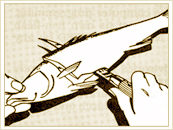
|
Step 1.
Make the first cut just behind the gills. Slice down the bone, then, without removing the blade, turn it and slice straight along backbone to the tail. Note that the fillet has been cut away from the rest of the fish.
|
|
Step 2.
After slicing fillet off at the tail, turn fish over and repeat procedure on the other side.
|
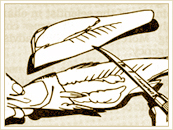
|
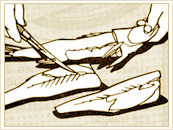
|
Step 3.
With both sides removed, you have cut away both fillets without disturbing the fish's entrails. This is the neatest and fastest way to fillet fish. Now to finish the fillets...
|
|
Step 4.
Next step is to remove the rib section. Again, a sharp, flexible knife is important to avoid waste. Insert blade close to the rib bones and slice entire section away. This should be done before skin is removed to keep waste to a minimum.
|
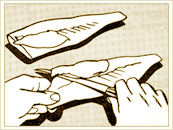
|
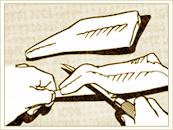
|
Step 5.
Removing the skin from each fillet is simply a matter of inserting the knife at the tail and "cutting" flesh from the skin. With the proper knife, it's easily done.
|
|
Step 6.
As a precaution cut away about one inch of the belly and dorsal sections (top and bottom) of the fillet. The belly and dorsal sections have more fat and, thus, potential contaminants.
|
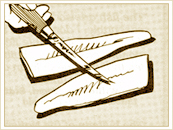
|

|
|
Step 7.
Each fillet is now ready to be placed into a Ziploc bag. Note that there's no waste. Do not over wash the fillets. This will preserve tasty juices and keep your salmon in its firm, natural state.
|